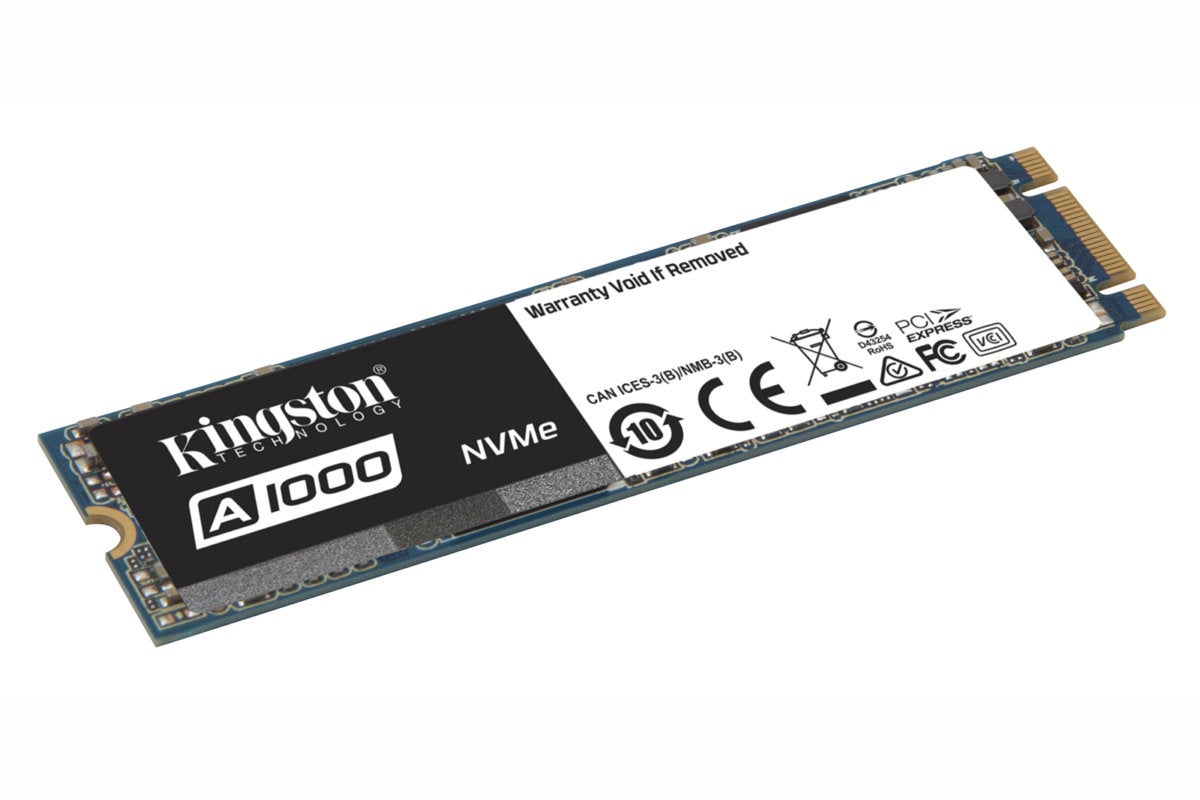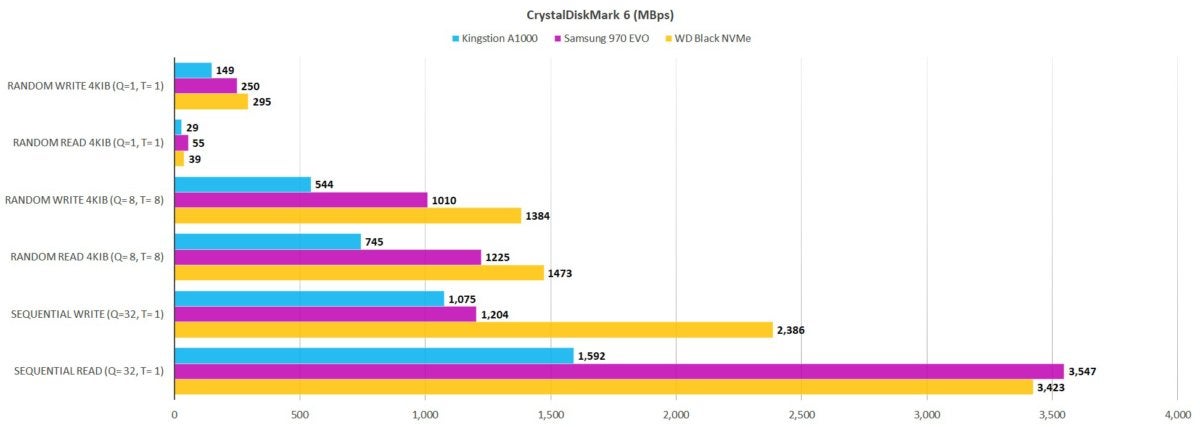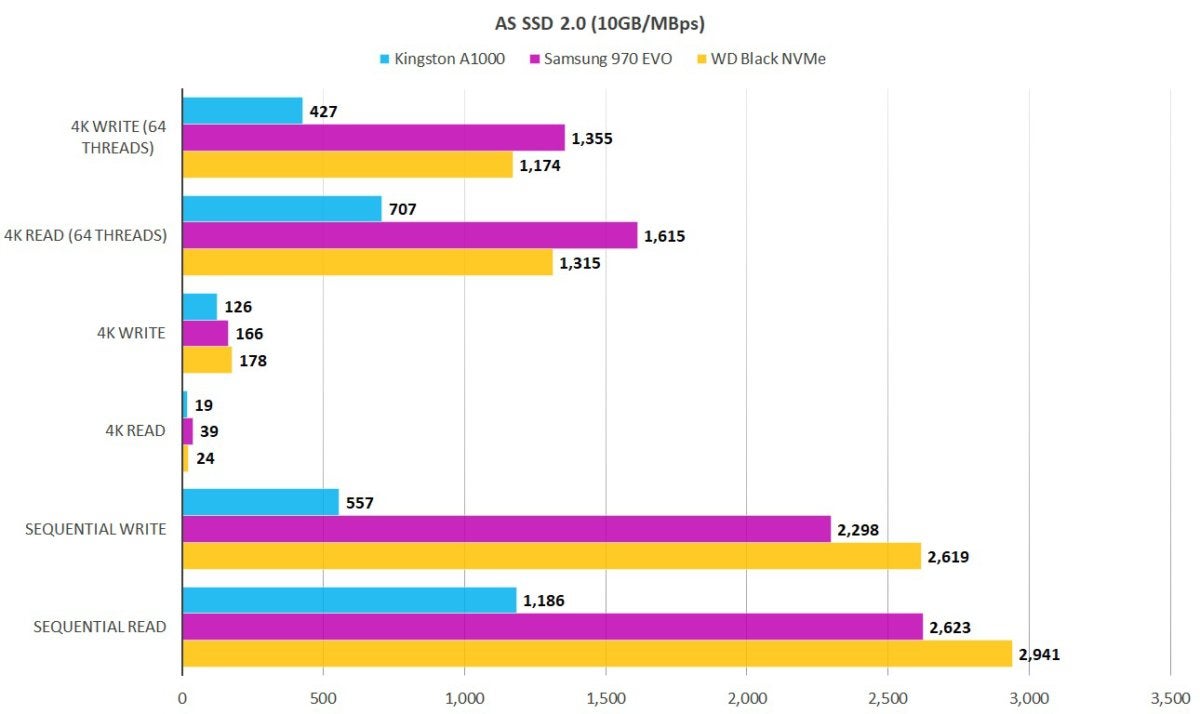Kingston A1000 SSD review: Being budget isn’t easy - begleydowasud

Melissa Riofrio/IDG
At a Glance
Proficient's Rating
Pros
- Affordable upgrade from SATA
- Basketball team-year warrant and upper TBW valuation
Cons
- Only PCIe x2 and a tiresome performer for NVMe
- The same price every bit a lot faster competition at the clock of this review
Our Verdict
You'll aim a discriminating encourage in computer memory carrying out o'er SATA from this M.2 NVMe drive, simply you tail end get about the double the boost from similarly priced drives.
Best Prices Today

$330.29
Piece faster is always better when it comes to storage, all things are relative. Even a slower M.2 NVMe SSD, such American Samoa the entry-dismantle Kingston A1000 NVMe reviewed present, offers a noticeable boost in performance over SATA SSDs. Quite noticeable.
The problem for Kingston and other entry-tier SSD vendors is that Samsung and WD are playing hardball with the pricing of what are essentially top-tier drives. The 970 EVO, WD Negroid NVMe, and Sandisk Uttermost In favor every last offer twice the public presentation of the A1000 for about the same price. For smaller vendors using third-party NAND, that's really bad news.
Design and specs
The A1000 follows the the usual M.2/2280 (22mm wide, 80mm long) form broker. That's well-nig the sized of a nonplus of gum, to borrow the common analogy.
Where the A1000 and some otherwise budget NVMe SSDs vary from the uppermost performers is in the PCIe implementation. The A1000 uses only 2 PCIe lanes, rather than the four a drive such American Samoa the Samsung 970 EVO, Samsung 970 Pro, and WD Black NVMe use. Assuming PCIe 3.0, that substance you're dealing with just subordinate 2GBps maximum throughput, as opposed to just under 4GBps with four lanes. It shows when it comes to large data transfers.
 Kingston
Kingston Kingston's A1000 could be a bargain—if the toll drops. At the time of this composition it cost about the same as drives with twice the speed.
A Phison 5008 controller wielding Toshiba 3D TLC (3-bit) NAND lies at the bosom of the A1000. The force back is available in 240GB (MSRP $146), 480GB (MSRP $266), and 960GB (MSRP $524) capacities. We tested the latter.
A varying percentage of the NAND, adequate 24GB total on any of the capacities, is used Eastern Samoa cache by simply writing a single bit to information technology, often referred to as putting it into SLC mode (Single-Layer Cell). The TLC as SLC acts as a secondary hive up to the 256MB of primary DRAM cache on the 240GB model, 512MB along the 480GB model, and 1GB on the 960GB model.
All capacities of the A1000 are are warrantied for fin geezerhood and/or 150 TBW (TeraBytes Statute) per 240GB of capacity. That's about median for the industry at this compass point, and twice what you accustomed get word. Vendors are now more confident in the lifetime of the NAND and their techniques for managing it.
Performance
The A1000's performance can't equate to that of the competitors I've already enumerated, but it is a snap in the weapon system compared to older SATA drives. If you're upgrading from a hard drive, or even a SATA SSD, the A1000 will constitute a pleasant surprisal. Windows will iron heel and operate importantly faster, and applications and files will open more quicker. Note that your system mustiness support booting from NVMe for a ram down like the A1000 to cost truly effective.
That said, the CrystalDiskMark 6 benchmark, display below, neatly illustrates the A1000's (in depressing) slower performance.
 IDG
IDG Small file performance from the A1000 is seemly. It's the sustained throughput that's the issue. Yearner bars are better.
Our large 48GB copy tests (the A1000 is in blue) show roughly the same pattern: good, but not great, with small files, and mediocre with titanic transfers. Again, this is compared to some other M.2 NVMe drives, not SATA.
 IDG
IDG As you can see, the A1000 doesn't reman that far behind the competition when elflike files are in manoeuvre. However, when transferring large files, it's lack of bandwidth comes into bring off. Shorter parallel bars are bettor.
The AS SSD 2.0 test showed the same basic results as the other drives, merely was even harsher in its judgment of the A1000 (again, in cheerless).
 IDG
IDG AS SSD didn't think often of the A1000. While it's a substantial upgrade over SATA, at that place are much faster M.2, NVMe drives available for about the same Leontyne Price. Longer bars are better.
Overall, the A1000 performed only hunky-dory. A nice upgrade from SATA, but far from showing off trueness capabilities of M.2 NVMe. The smaller capacities may not perform as comfortably as the 960GB version I tested, though reported to Kingston's data canvass, the dropoff is relatively minor. Much is not always the case with lour-capacity drives due to fewer chips and less cache. For instance, Samsung's 970 EVO drops remove mightily in the 250GB content.
If you get a really good dole out
The A1000 NVMe is a modest NVMe drive, though non a great one. At the time of this writing, you could get a great single, such as the WD Black NVMe/Sandisk Extreme Pro (they're the same beat back), operating theatre the Samsung 970 EVO for about the same price.
Still, the price may free fall. If you find a spate on one, the A1000 is a worthy upgrade from SATA.
Note: As of 08/03/2018, the 960GB A1000 was available for about $220, less than incomplete what it was when we reviewed it. At that price, it's well worth considering. As we said, if you get a great deal…
Best Prices Nowadays

$330.29
Note: When you purchase something after clicking links in our articles, we may bring in a small commission. Read our affiliate link policy for more details.
Jon is a Juilliard-trained instrumentalist, former x86/6800 programmer, and long-time (late 70s) computer enthusiast living in the San Francisco bay sphere. jjacobi@pcworld.com
Source: https://www.pcworld.com/article/401766/kingston-a1000-ssd-review.html
Posted by: begleydowasud.blogspot.com

0 Response to "Kingston A1000 SSD review: Being budget isn’t easy - begleydowasud"
Post a Comment